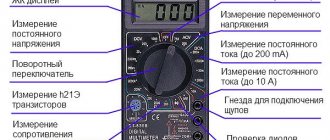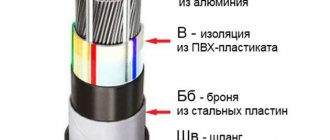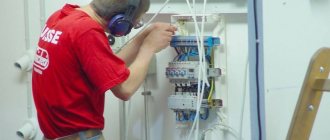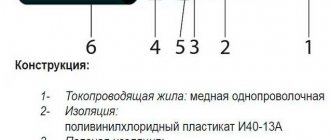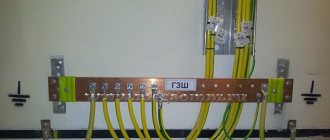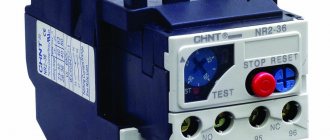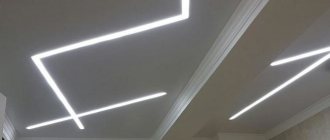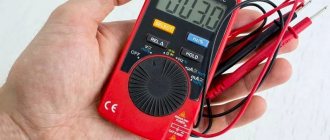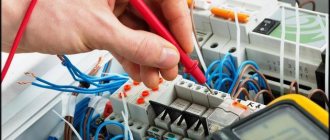Multimeter dt830b instructions for use
A multimeter is one of the inexpensive measuring instruments that is used by both professionals and amateurs who repair home wiring and electrical appliances.
Without it, any electrician feels like he has no hands. Previously, three different instruments were required to measure voltage, current, and resistance. Now all this can be measured using one universal device. Using a digital multimeter is very easy. The main two rules to remember:
- ⚡where to properly connect measuring probes
- ⚡in what position should the switch be set to measure different quantities?
Multimeter appearance and connectors
What do these inscriptions mean:
- OFF - the device is turned off (to prevent the device batteries from running out, set the switch to this position after measurements)
- ACV - measurement of variable U
- DCV - constant U measurement
- DCA - DC current measurement
- Ω - resistance measurement
- hFE - measurement of transistor characteristics
- diode icon - continuity test or diode test
Switching modes occurs using the central rotary switch. When you first start using your digital multimeter, it is recommended that you immediately mark the pointer mark on the switch with contrasting paint. For example like this:
Most device failures are due to the incorrect choice of switch position.
Power is supplied from a Krona battery. By the way, by looking at the connector for connecting the crown, you can indirectly judge whether the tester was assembled in a factory or somewhere in Chinese “cooperatives”. With high-quality assembly, connection occurs through special connectors designed for the crown. Lesser quality options use regular springs.
The multimeter has several connectors for connecting probes and only two probes. Therefore, it is important to correctly connect the probes to measure certain quantities, otherwise you can easily burn the device.
The probes are usually of different colors - red and black. The black probe is connected to the connector labeled COM (translated as “common”). Red probe into the other two connectors. The 10ADC connector is used when it is necessary to measure current from 200mA to 10A. The VΩmA connector is used for all other measurements - voltage, current up to 200mA, resistance, continuity.
The main criticism is caused by the factory probes that come with the device. Almost every second owner of a multimeter recommends replacing them with better ones. However, their cost can be comparable to the cost of the tester itself. As a last resort, they can be improved by strengthening the bends of the wires and insulating the tips of the probes.
If you want high-quality silicone probes with a bunch of tips, then you can order them with free shipping on AliExpress here.
Previously, pointer testers were also widely used. Some electricians even prefer them, considering them more reliable. However, due to the large error of the measurement scale, it is less convenient for ordinary consumers to use them. In addition, when working with a dial multimeter, it is imperative to guess the polarity of the contacts. For digital ones, if they are connected to the poles incorrectly, the readings will simply be displayed with a minus sign. This is normal operation and will not damage the multimeter.
Cheap multimeter DT-830B for $1.94 - Review
So, the multimeter has arrived with a coin discount... thanks to Giwery for his discount post. I drove the multimeter for quite a long time - 1.5 months. A few guts, a burning smell and requests for help below. ATTENTION!!! I didn’t compress the photos at 80+ meters... but the photos are from my phone
Background:
Back in warm July, a kind man named Giwery shared with the people the joy of where they could spend some coins. For which I am very grateful to him! Those who don't mind can come in and say thank you too.
Differences between 830 series multimeters:
The multimeter arrived in a standard yellow package:
In a beautiful box:
Package contents:
multimeter, test leads, instructions letter from the seller.
The probes say 1000V, but I would be careful...
And even with a letter from the seller:
And instructions:
I glanced at the instructions, I wanted to find the characteristics of the probes, but as it turned out, the instructions are the same for all types. I liked the section on replacing the battery and fuse: open the cover and replace the battery and fuse. In my old DT-830, purchased back in 2003, the fuse can actually be removed and replaced, but here it’s not so easy.
In general, there are no questions about the parcel, only a wish that the packaging be thicker, otherwise nothing stops our mail...
Characteristics:
- screen maximum value - 1999
- works from the crown (9V)
- Diode testing
- Transistor hFE test
- The instructions contain references to overload protection
- Dial-up function - nope, there is no such thing...
from the instructions
The switch positions are divided into sectors:
OFF/on - device power switch DCV - DC voltage measurement (voltmeter) ACV - AC voltage measurement (voltmeter) hFe - transistor measurement switching sector. DCA - direct current measurement (ammeter). 10A - sector of the ammeter for measuring large values of direct current (according to the instructions, measurements are carried out within a few seconds). Diode - sector for checking diodes. Ohm - resistance measurement sector
Instead of diode testing, I would like to have a sound test, and also temperature measurement, but this model does not have it. DT-838 has it.
The multimeter was taken to work for comparison with a more accurate brother (Fluke 115). Since I myself am not involved in electronics, I asked knowledgeable people at work to check the accuracy. Before that, I took it apart and took a photo:
Entrails
Additional Information
Today is exactly one week since I am writing this report. I found him!
The first thing we decided to do was check the voltage in the outlet. 2 probes in the lower positions in the multimeter and the other ends in the socket holes, and the switch up. BIG BAGA BOOM!
))
We disassemble it again and see that a tiny strip of track near the screw has burned out, it looks like the screw turned out to be a conductor))
The master (hereinafter with all due respect to the person) looked and said that now we’ll fix everything! I threw the jumper directly and started testing further.
So the Master began to set the voltage on the left tester through the laboratory unit and compare it with the readings of the right one (the patient), all the time after the changes he muttered - “not bad, not bad.” The Master's desk is not in disarray, I just came close to it at 7:30, and we start working at 8:30. You understand that before work starts, everyone rests) And I’m boring with my homemade products, you know...
The power supply on which everything was set - I twisted it)
Everything was “not bad, not bad,” according to him, and then we moved on to testing the resistance: and then there was an ambush ... none of the positions of the resistance test work - the screen is dead. And the continuity of the diodes is also deader than dead...
We started to take it apart again and see what could have happened. I got in the way as best I could and, at my request, they changed two resistors:
at 10 and 9.1 Ohm - it didn’t help. We fussed about for half a day, then I said that for now it’s enough to suffer and we need to think...
I just felt terribly uncomfortable in front of the person that I was distracting him for 120 rubles...
Dear experts! And now - attention, question!
Maybe someone knows how to treat my patient? It's not a matter of money spent on it, it's a matter of interest and passion. I saw that I was not the only one who ordered it from the meal... perhaps someone is now sitting and quietly giggling (or a villainous laugh can be heard)))
The probe resistance is approximately 0.3 Ohm. It was not possible to measure the readings of the multimeter itself...
Results: According to the Master, the multimeter is quite accurate for its price category. For home use it will cost 120 rubles... Even after using it to make fire, more than half of the functions work
Cons: Sounds great! (I also advised the Master to put it on the table when they climbed into 220, and not to hold it in his hands)
I am attaching instructions in Russian for the 830 series, I got it online.
There are no complaints about the seller of the multimeter. He was worried that the goods would take a long time to arrive, he wrote and asked to be patient. Although I didn’t even remember him)
I wrote to him that the multimeter burned out with all possible courtesy:
Additional Information
He suggested opening a dispute, which is rarely seen from a seller.
Z.Y. After writing I found another review, but I tried... so I'll post it anyway.
Z.Y. Z.Y. and not alone
Additional Information
Thank you all for your support. It's nice to know that your efforts were not in vain and that it will help someone.
Basic Multimeter Operations
Voltage measurement
How to use a digital multimeter to measure voltage? To do this, set the switch on the multimeter to the appropriate position. If this is the voltage in the outlet at home (alternating voltage), then flip the switch to the ACV position. Insert the probes into the COM and VΩmA connectors.
First of all, check that the connectors are connected correctly. If one of them is mistakenly installed in contact 10ADC, a short circuit will occur when measuring voltage.
Start measuring from the maximum value on the device - 750V. The polarity of the probes does not play any role at all. It is not necessary to touch the zero with a black probe, and the phase with a red one. If a much lower value is displayed on the screen, and the number “0” appears in front of it, this means that for a more accurate measurement, you can switch to another mode, with a smaller voltage level scale that your multimeter allows you to measure.
When measuring DC voltage (for example, electrical wiring in a car), switch to DCV mode.
And you also start measuring from the largest scale, gradually lowering the measurement levels. To measure voltage, you need to connect the probes in parallel to the circuit being measured, while using your fingers to hold only the insulated part of the probe so as not to get under voltage yourself. If the display shows a voltage value with a minus sign, this means that you have reversed the polarity.
ATTENTION: when measuring voltage, be sure to check that the multimeter scale is set correctly. If you start measuring voltage with the DCA switch in the on position, i.e., measuring current, you can easily create a short circuit right in your own hands!
Some experienced electricians recommend holding both probes in one hand when measuring the voltage in an outlet. If the probes are poorly insulated and breakdown, this will allow you to protect yourself to some extent from electric shock.
The multimeter operates on a battery (a 9-volt crown is used). If the battery starts to run low, the multimeter starts to lie shamelessly. In the outlet, instead of 220V, it may seem like 300 or 100 Volts. Therefore, if the device readings begin to surprise you, first check the power supply. An indirect sign of battery discharge can be chaotic changes in the readings on the display, even when the probes are not connected to the object being measured.
Current measurement
The device can only measure direct current. The switch must be in the – DCA position.
Be careful! When measuring current, if you do not know approximately what limits the current will be, it is better to start measuring by inserting the probe into the 10ADC connector, otherwise measuring a current of more than 200mA at the VΩmA connector can easily blow the internal fuse.
Here, probes, unlike voltage measurements, must be connected in series with the object being measured. That is, you will have to break the circuit and then connect the probes into the resulting gap. This can be done in any convenient place (at the beginning, middle, end of the chain).
How to use multimeter probes dt-830b, dt-832v, dt-838, instructions for use
To use the device for its intended purpose, you must first expose the probes and then touch them to a wire, socket, switch, and so on. For this, there are three special connectors on the front side of the multimeter. If we talk about measuring by color, then this type of measurement should be used only when you carry out manipulations in a DC network. If we talk about alternating current, then in this situation there is no difference in how exactly the probes are connected.
How to use a multimeter instructions for dummies video
When you take voltage measurements, be very careful not to touch those areas of the probes that are bare. Before starting work, it is also very important to check whether the probes are correctly connected to the connectors located on the front side of the device. You should always remember that if you use dt-832, 830, 838 and other models incorrectly, this may cause a short circuit or more serious problems. Therefore, the instructions must be studied without fail, regardless of the amount of knowledge in this area.
Device information
The DT830B model is a multifunctional measuring instrument - a multimeter, which is widely used among electricians. Using this universal tool, you can determine the required parameters and electrical characteristics in the shortest possible time.
The DT multimeter is not fully classified as professional equipment and is used mainly in domestic conditions. However, the DT830B is equipped with a wide measurement range, test leads, and self-diagnosis capabilities. Therefore, the device is often used by professional electrical engineers, providing accurate measurement results. The multimeter is powered by 9-volt KRONA batteries. In general, the model is a budget option and is sold on the market at a price of up to 400 rubles.
The main difference between the DT830B digital device and analog instruments is the ability to measure many parameters, and all obtained data is presented in digital format. All elements of the circuit are placed in a small case, on the front of which the main switch is installed in the center. It is the main control element and covers approximately 20 positions.
There are icons around the circle indicating the corresponding operating modes. All obtained measurement data is displayed on a digital liquid crystal display.
Device information
The multifunctional tester is easy to use and universal. The model is suitable for work at home, but it has all the features of a professional tool. The device includes measuring probes, a tool for self-diagnosis and a large scale of indicators. The multimeter receives power from a special 9 W power source. The manufacturer has provided only one battery in the set.
The device looks like standard testers, but has several significant differences. The data is presented in digital form, and the device itself can operate with several parameters. All internal elements are enclosed in a reliable housing. The central place on the surface is occupied by a switch. The main advantages of the multimeter:
- performance;
- portability;
- ergonomics.
The device is easy to operate thanks to the massive handle with twenty positions. Around it there are designations of types of work, which is useful for inexperienced users. Data about the parameter being measured is displayed on the digital LCD screen.
Specifications
Despite its wide functionality, the DT multimeter still lags behind professional instruments, losing to them in measurement accuracy and service life. However, the high sensitivity of the multimeter provides good measurement results, and in terms of basic indicators it is only slightly behind more expensive devices.
The DT830B multimeter is designed for a constant current of 10A, the maximum constant voltage is 1 kV. The AC voltage is in the range of 200-750 V. The liquid crystal display has a resolution of 3.5, which is a good indicator. The maximum resistance limit that can be measured is 200 kOhm. The device operates normally at temperatures of 0-40 degrees.
The dimensions of the multimeter are 126x70x28 mm. The device itself is very light and weighs only 137 grams. Compared to professional models, the number of functions is somewhat limited. However, if we take other household testers for comparison, the DT830B digital multimeter is noticeably superior to them, thanks to emergency indicators, an extended measuring scale, a diode tester and other additional options.
Operating modes
The desired operating mode is set by the switch by placing its handle opposite the corresponding sector:
- DCV. Additionally divided into five ranges. This sector is intended for measuring DC voltage in the range 0-500V. Maximum voltage occurs infrequently, for example, during TV repair. When the switch is set to 500V, an HV warning icon will appear in the upper left corner of the display to indicate the maximum level and the need for attention and caution. If the voltage value is not known in advance, switching is performed from the maximum position with a gradual transition to lower values. Failure to comply with this condition may lead to inaccurate readings or failure of the device.
- ACV. Designed for measuring alternating voltage. The sector is divided into two parts - 200 and 500V. When using the 220-380V range you need to be extremely careful. The procedure is the same as in the previous constant voltage sector.
- DCA. This sector performs the function of a milliammeter and is intended for measuring small direct currents. It is not recommended to use this sector unless necessary, and caution should be used when measuring large currents. In this case, you need to ring the chain for no longer than a few seconds.
- hFE. The sector performs continuity measurements of transistors and checks for breakdown or breakage. Elements are tested regardless of their conductivity. The legs of the transistors must be placed in the appropriate sockets, as indicated on the special socket.
- DIODE sector. When the diode is working properly, the voltage drop in the forward direction is shown in the range of 400-700 mV. For the reverse direction, infinity is used. If the diode is faulty, then a value close to zero means a breakdown, and one close to infinity means a break.
- OM sector. Used for resistance measurements. The measurement range is in the range of 200-2000000 Ohms. You should take into account the errors of the Chinese multimeter and its too high sensitivity when making accurate measurements. It is imperative to take into account the resistance that occurs when the probes are connected to each other. This is especially true when measuring resistances that are too small.
Measurements of basic parameters
The operation of the DT-830B multimeter is best considered using the example of measuring parameters that are most often encountered in everyday life. You can start mastering the device by measuring the voltage in a 220V network.
First of all, the expected measurement limit is set. The value "200" is not suitable, so you will have to use "750". The probes are installed in the required connectors, after which all that remains is to touch the two contacts available in the socket. The result will be displayed on the screen.
If the DT830B multimeter measures DC voltage, a minus sign may appear on the display. It does not always appear, since it depends on the potential of the probe with the black wire included in the COM connector. A minus sign will be displayed when the black wire has a positive potential, indicating reverse polarity.
Quite often it is necessary to find out the identity of the wire, that is, determine the phase and zero. In this case, one probe touches any grounded surfaces - ground wire, batteries, pipes, etc. The other probe alternately comes into contact with the conductors of the cable whose phase needs to be determined. In case of contact with a phase wire, a result in the range from 220 to 240V will appear on the screen.
If there are no metal grounding surfaces, another method is used for testing. You need to take one probe in your hand and touch the cable cores with the other one in turn. In this case, the multimeter will produce values of 60-240V, which also indicates the presence of a phase. The difference in readings depends on the shoes and the surface on which the examiner stands.
There is no need to be afraid of electric shock, since the DT device has a high intrinsic resistance. The most important thing is not to touch the open parts of the probe involved in the phase search. When performing such a check, you should be extremely careful and careful.
Everyone knows that electric current flows in a closed circuit. Therefore, in order to measure the current, one of the wires of this circuit must be open. After this, with the help of probes, a single circuit is formed. When attempting to measure voltage in current measurement mode, a short circuit will occur and the device will fail. The tester itself has zero internal resistance.
Before making measurements, the type of current must be correctly determined, which may be direct or alternating. If you make the wrong choice, nothing bad will happen, the device will just not show anything.
It is very important to remember that when installing probes into an electrical circuit, the voltage must be turned off. You should study the markings of the probes for the maximum current holding time. Typically, the measurement lasts no more than 10 seconds, after which the wire may begin to heat up and the insulation will melt.
Modes and maintenance
Around the switch, the housing is divided into sections that determine the mode of use of the device. Sometimes sectors allow you to accurately indicate measurement fluctuations. The device can operate in two modes - DCV and DCA. The first makes it possible to measure the voltage of a direct electric current as a voltmeter. DCA activates ammeter mode.
The device has a section for assessing the functionality of diodes. To do this, you need to insert the probes into the second and third sockets, and use their tips to measure the resistance. If the indicator is the same in the forward and reverse directions, then the element is faulty.
The manufacturer guarantees a long service life of the multimeter, but this is also affected by the frequency of maintenance. After each use, the device must be cleaned of dust and dirt. To use the DT 830B multimeter for a long time, it is necessary to diagnose it. Do not use the device in conditions of high humidity , as the accuracy of the obtained parameters is reduced and some elements may be damaged.
The multimeter can be transported on any vehicle, protecting it from extreme temperatures, moisture, mechanical damage and voltage surges. The device should be stored in a well-ventilated area at temperatures up to 40 degrees. It is necessary to protect it from exposure to frost , contact with alkalis, dust, acids, as all of this causes corrosion.
The device is suitable for use at home. This is the best option for training novice electricians. It meets the parameters of the electrical network and household appliances. If the case or internal parts are damaged, you need to contact a specialist; you can disassemble the multimeter yourself only if you have experience working with similar devices.

